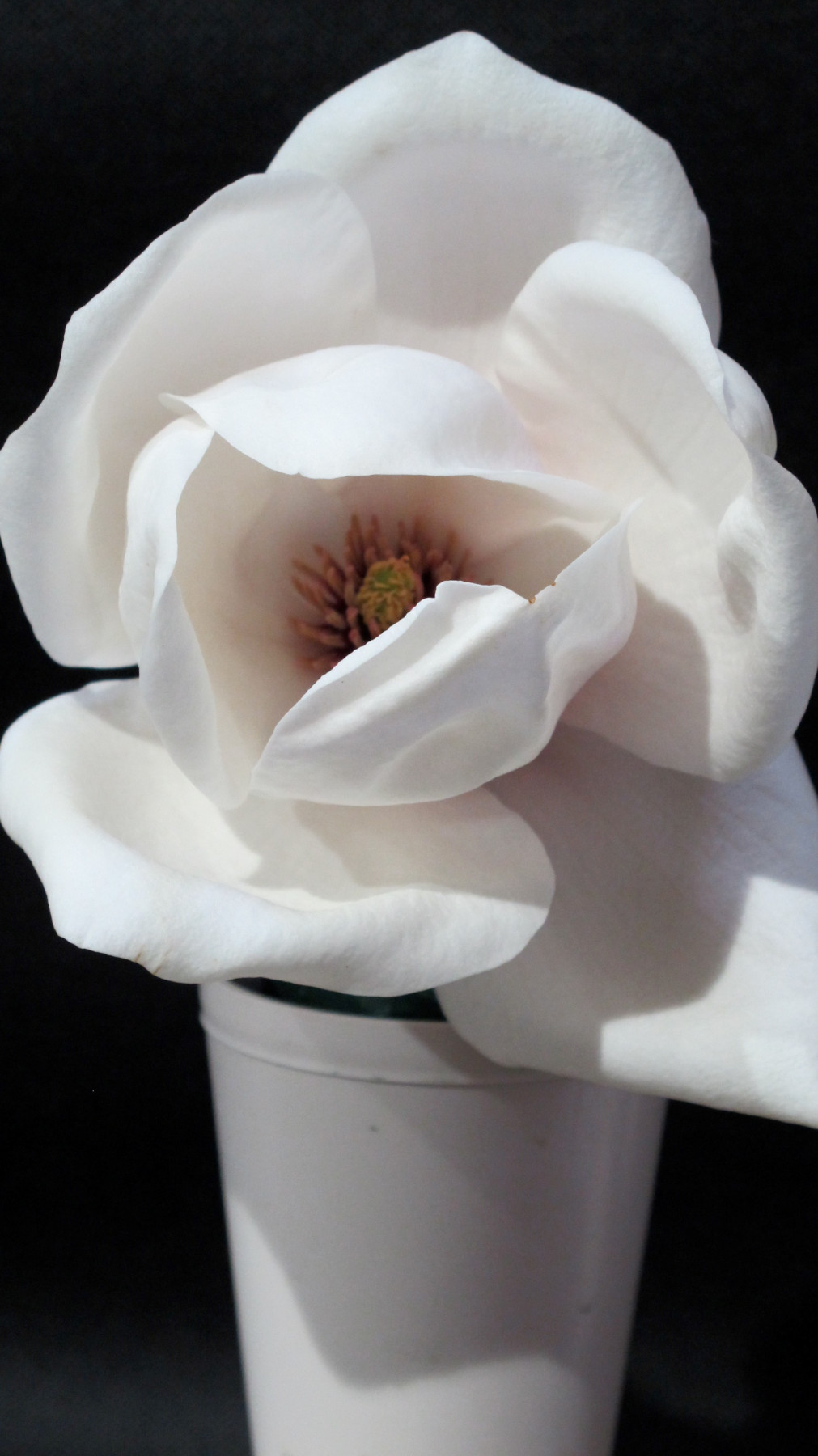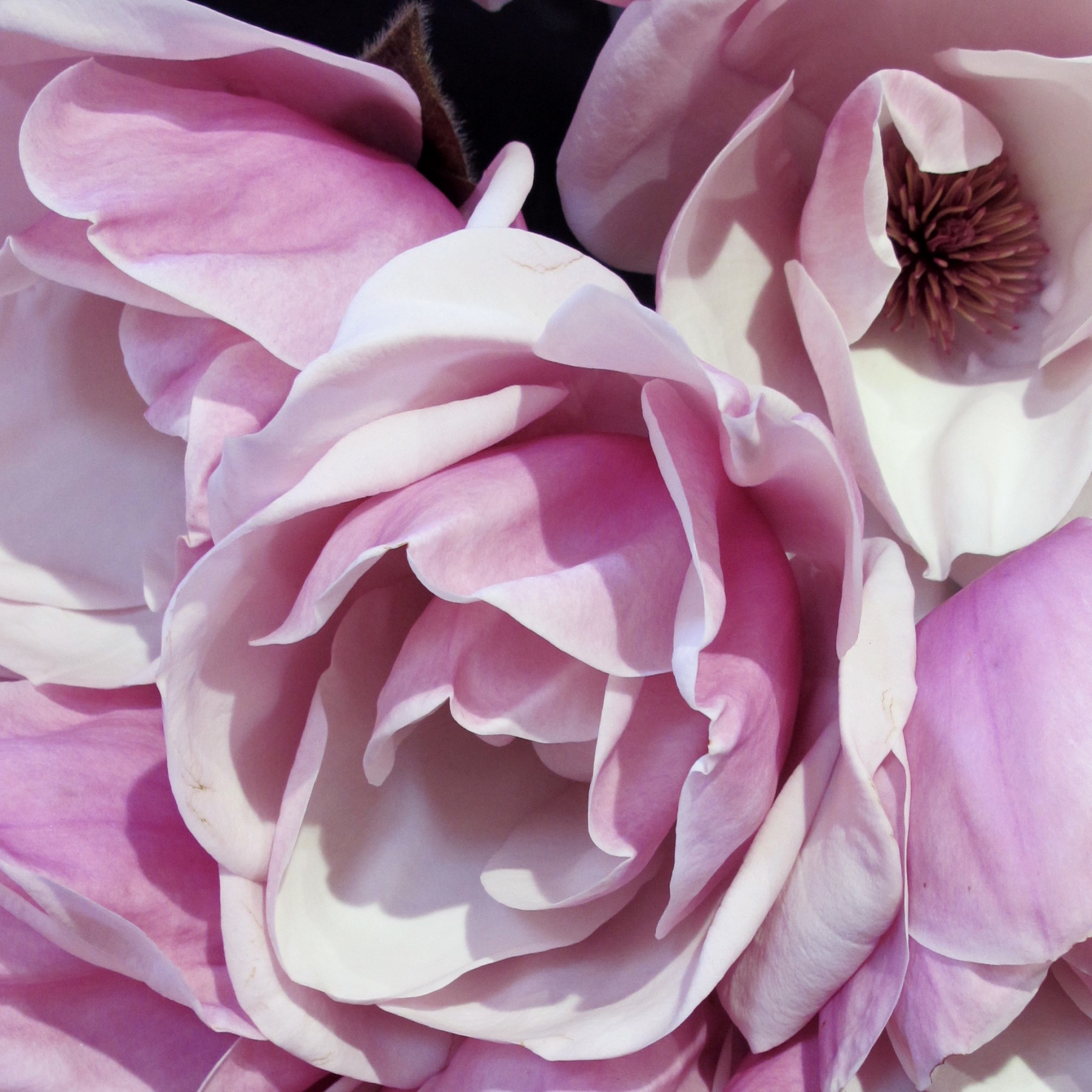
One of the earliest flowers I ever encountered was the magnolia. I spent my childhood in Ealing in West London, then known as the Queen of the Suburbs. It was full of Victorian villas and practically every front garden had a tall magnolia with tulip-shaped, pale-pink flowers in spring. These rose into the air to a height, but they could be admired from the top of the 65 double decker that ran between Ealing and Kew. Every April I would go into a trance and pray that someone would ring the bell for a unrequested stop. That meant the bus would slow down and give me a better view of the wonderful flowers.
You see there something quite surreal about a magnolia flower: they look as they don’t quite belong with their thick, raw-silk petals and their blowsy contours. They might have been part of a French Impressionist’s imagination, all swirl and brush strokes, but of course they do exist and they have done so for millions of years. The magnolia is one of our most ancient plants and fossils from the Tertiary Period ( 2 – 65 million years), when vast forests surrounded the arctic regions, have proved it.
At one time these glamorous beauties would have thrived throughout the single landmass, pollinated by beetles, because the bee hadn’t yet evolved. That’s quite a thought.Time brought change. The earth’s single landmass drifted apart and magnolias, like so many of our garden plants, found themselves with one foot in Asia and one in North America. The path of evolution took them along separate routes. The climate changed and widespread glaciation killed most of magnolias off, except for certain hotspots in parts of China, Japan, Korea and eastern North America. The Orientals are always more exciting than their American counterparts and that goes for most genera.

In all there are 300 species of this flamboyant plant in the wild. The first magnolia to come to Britain was an American species, M. virginiana, acquired by Henry Compton, the Bishop of London, from John Bannister in 1687. In 1730 it was followed by another American species, M. grandiflora, collected by Mark Catesby ( 1682 – 1749), a botanist who wrote The Natural History of Carolina. This evergreen, commonly called Bull Bay or Southern magnolia, is often grown on warm walls because most forms need a kind climate. There are a hundred named forms but my own favourite is ‘Samuel Somner’ . This has leathery green foliage, backed by felted chestnut-brown indumentum. When the wind catches the rich-green, high-gloss leaves the golden looking undersides show themselves.
‘Samuel Somner’ was raised by The Saratoga Horticultural Research Foundation and named after their President Samuel Somner in 1961. It is hardier than most and flowers when young. The cream-white flowers appear in summer with a sweet hint of lemon and, as one flower fades, another opens. ‘Exmouth’ is the oldest English clone, grown in the early 18th century Sir John Colliton in his Exmouth garden. Towards the end of the 18th century the first Asian species arrived – M. denudata. this was known as the Chinese Yulang or Lily Tree and it the blush-white flowers symbolized purity. Trees were pot-grown in China and forced into precocious flower for Emperor. Once established this was hybridised in 1828 with M. liliiflora the purple magnolia, by Étienne Soulange-Bodin. The hybrid became the ubiquitous M. x soulangeana – the most common magnolia grown in this country and North America
This was the magnolia that popped up all over Ealing, planted in the second half of the 19th century in the newly built villa gardens. I inherited one in my Hook Norton garden, Homefield, and it was a full of flower by April. Frost was always a worry because the tulip-shaped flowers trapped cold air.
The gappier shape of the star magnolia’s flowers , M. stellata, allow any cold air to escape. This is a smaller magnolia so it’s perfect for a smaller garden. It arrived from Japan in 1877. The shrub-like M. sieboldii, from Korea, had arrived by 1888 and the downward-facing flowers have a cherry-red centre.
However the real age of the magnolia began in the early years of the 20th century when Ernest Chinese Wilson, George Forrest and Frank Kingdon Ward began to collect Himalayan species, most notable M. campbellii. These were avidly collected by large landowners and they thrived in moister, cooler maritime parts of Britain including Cornwall and North Wales. Go to the National Trust’s Bodnant Gardens close to the River Conwy and it’s possible to gaze over the steep wooded valley, across a sea of magnolia flowers.

Cornwall’s famous gardens are full of magnolias. The National Collection is held at Caerhays Castle and is part of a network of 630 collections held on 450 sites that safeguard around 70,000 species and cultivars. Well over half the magnolia species in existence in the wild are classified as being endangered and the purpose of national collections is to preserve as many species and cultivars of magnolias as possible.
Magnolias were a plant hunter’s dream because their chunky black seeds are so easy to collect. However finding and growing the trees themselves was often harder. M. sargentiana, Sargent’s magnolia, is native to northern and western Yunnan and Sichuan. This large tree was first described by Père Jean Pierre Armand David in 1869. It was rediscovered in 1903 by Ernest ‘Chinese’ Wilson, from David’s notes, and seeds were sent to Charles Sprague Sargent (1841 -1927) in 1908, the first Director of the Arnold Arboretum. The severe climate of Boston, Massachusetts USA made their survival precarious. Finally Sargent took the bold step of shipping all his young plants to Chenault’s Nursery at Orleans in France. The plants survived in this benign climate and by 1918 M. sargentiana had been distributed to Kew and other leading botanic gardens.
I have a particular soft spot for M. sargentiana var. robusta, also discovered by Wilson about thirty miles away from where M. sargentiana grew. This wide, spreading tree grows well in the south east of England and in the south west. A particularly fine specimen grew at High Beeches Garden, but was flattened in the typhoon of October 1987. It was propped up and re-bloomed ten years later. The Daily Telegraph had a sensational picture and needed a story and they could only fine me! That magnolia launched my writing career!



